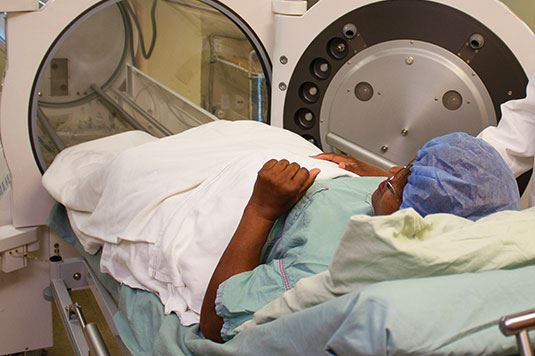
Open Accessibility Menu
Hide
dfh
Close Alert
Close Alert

We all know that oxygen is essential to life, but it also plays an important role in wound healing. Not only does it help kill infection-causing anaerobic bacteria, it helps power regenerative processes at the cellular level. For those who suffer from chronic or non-healing wounds, high doses of oxygen under pressure can help kick-start the stalled healing process.
With hyperbaric oxygen therapy (HBOT), patients are treated with pressures 2-2.5 times the normal atmospheric pressure (air is usually about 21% oxygen). While this therapy has applications in the treatment of carbon monoxide poisoning and decompression sickness, it’s used in wound healing to improve collagen formation and to promote the development of new blood vessels at the wound site. Over time, it can help improve even the most stubborn wounds.
At the Washington Center for Wound Healing and Hyperbaric Medicine, we offer hyperbaric oxygen therapy as an outpatient service to complement other modern developments in wound care such as biological skin substitutes, negative wound pressure therapy, compression wraps, and debridement.
Your doctor may recommend HBOT in the treatment of:
During treatment, a patient lies down on a bed that slides into a clear acrylic single-person hyperbaric chamber, or monoplace chamber. The chamber is pressurized with 100% oxygen until the prescribed pressure is reached.
This may cause pressure in your ears similar to scuba diving. Usually, swallowing or yawning can alleviate any discomfort.
Each HBOT session lasts approximately two hours, during which patients can rest or watch a movie while under constant supervision by HBOT techs. A typical course of treatment involves sessions 5 days a week for up to 8 weeks.
Complications associated with hyperbaric oxygen therapy are rare. The most common side effects are fatigue and lightheadedness.
For those with diabetes, we strictly monitor blood sugar levels, due to increases in metabolic functions. We monitor blood sugar before and after each session, and encourage protein-rich snacks to keep blood sugar levels stable throughout the process.
Hyperbaric oxygen therapy isn’t a stand-alone treatment and its healing effects won’t be immediately apparent. This is a therapy that requires multiple sessions to achieve the desired result. However, when combined with other therapies and medications, patients should see a reduction in the size of wounds after a few weeks of treatment.
If you have a chronic or non-healing wound and would like to explore hyperbaric oxygen therapy, consult your primary care provider. To learn more about Washington Center for Wound Healing and Hyperbaric Medicine, visit our Washington Hospital website or call 888.449.6863.
Posted July, 2019